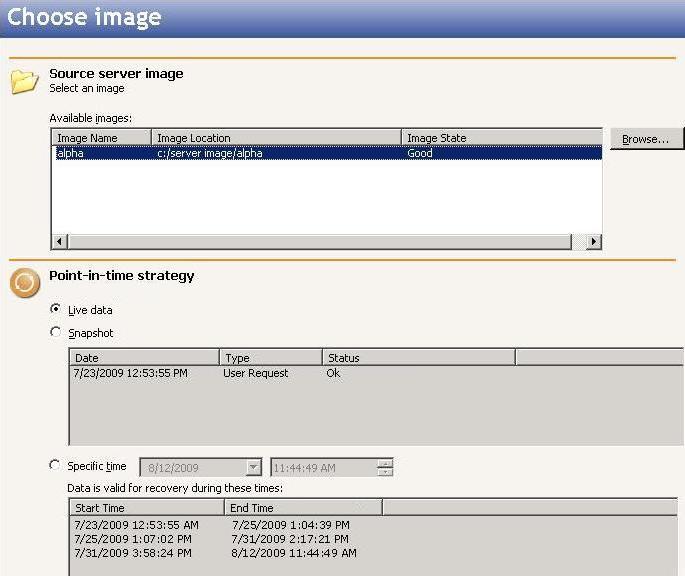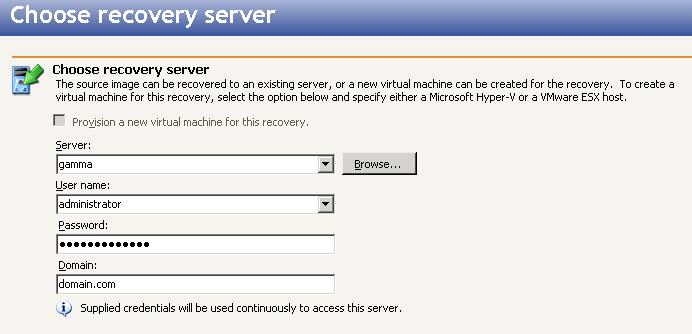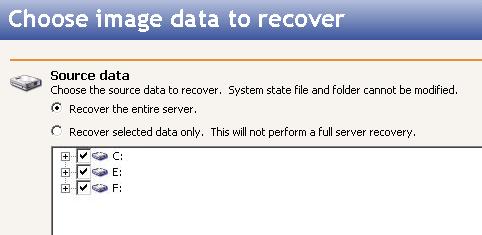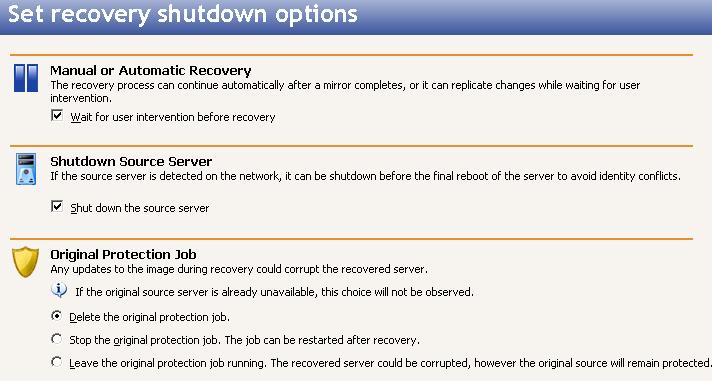- There are two ways to begin the recovery process.
- Click Recover data from the left navigation pane and identify the repository server that contains your source data that you want to recover. Click Next to continue.
- Highlight the data protection job on the Monitor page and select Recover from the toolbar. This automatically identifies the repository server that contains the source data that you want to recover.
-
Select the image of the source that you want to recover and the point-in-time strategy.

- Available images—Select the image of the source that contains the data you want to recover. If the image is not displayed, click Browse to look for the location of the server image.
- Live data—Select this option to recover to the live data that is currently stored on the repository server.
- Snapshot—Select this option and choose a snapshot from the list to recover to the data stored in that snapshot. If you did not enable snapshots or there were no snapshots taken on the repository server, there will be no snapshots in the list.
- Specific time—Select this option and choose a specific date and time to recover the data from that point in time. The table below the date and time fields allows you to confirm that the Double-Take RecoverNow data is valid for the point in time you are selecting. If you did not enable continuous data protection when you configured protection or if the TimeData initialization has not completed, this option will not be available.
- Click Next to continue.
-
Select the recovery server. If you used the Double-Take RecoverNow built-in installation to push a copy of Double-Take RecoverNow to the recovery server, that copy will automatically be activated when you select it as a recovery server. The copy will automatically deactivate after five days.

- Provision a new virtual machine for this recovery—Do not enable this option. This setting is only if you are recovering to an automatically provisioned virtual machine.
- Server—Specify the name of the recovery server. You can also click Browse to select the name from Active Directory or from a network drill-down list. You can select your repository server as the recovery server, but keep in mind that the repository server role and any other source images will be lost.
- User name—Specify a user that is a member of the Double-Take Admin security group on the recovery server. If your original source was the only domain controller in your network, you must specify a local account in the local administrators group on the recovery server.
- Password—Specify the password associated with the User name you entered.
- Domain—If you are working in a domain environment, specify the Domain.
- Click Next to continue.
-
By default, Double-Take RecoverNow will Recover the entire server. If you only want to recover selected data, select Recover selected data only. In either case, you can, if desired, exclude files that you do not want to recover, but be careful when excluding data. Excluded volumes, folders, and/or files may compromise the integrity of your applications.

Volumes, folders, and files that are marked with a checkmark are included. If there is no checkmark, the item is excluded. Expand and collapse the directory tree and click on an item to add or remove a checkmark. Once you have configured the data to recover, click Next to continue.
The Select all and Deselect all buttons allow you to quickly select or deselect all data on your server based on your system state or selected data only choice. These buttons do not change what is selected for the system state, which is defined by Double-Take RecoverNow and cannot be modified.
-
Specify if your recovery server is in a LAN or WAN environment with respect to your original source.

- LAN recovery—If your recovery server is on a LAN with your original source, the original source name and the IP address(es) will be applied to the recovery server. Specify which network adapters on the recovery server that you want to take over for the network adapters on the original source.
- WAN recovery—If your recovery server is located across a WAN from your original source, the original source name will be applied to the recovery server, but the IP address(es) of the original source will not be used. Instead, the IP address(es) of the recovery server will be used. If desired, you can select to Update DNS servers, which will allow you to specify how to resolve server names and IP addresses. If you do not select Update DNS Servers, you must manually modify DNS after the recovery is complete.
- Click Next to continue.
- If you selected to update your DNS servers for a WAN recovery type, specify your DNS update options.
- DNS Domains—Click Add and specify the name of your DNS Domain. Repeat this for each DNS domain. If you want to remove a domain in the list, highlight the name and click Remove.
- User name—Highlight a DNS domain and specify a user account that has privileges to update DNS.
- Password—Specify the password associated with the user account you entered.
- DNS Servers—Click Add and specify the IP address of a DNS server in the DNS domain. Repeat this for each DNS server in the DNS domain. If you want to remove a server from the list, highlight the address and click Remove.
- IP addresses—For each IP address on the source, select an IP address on the recovery server that will take over for that source IP address.
- Once you have your DNS updates configured, click Test DNS to determine if your DNS updates will be successful.
- Click Next to continue.
-
Specify your recovery shutdown options.

- Wait for user intervention before recovery—Specify if you want to pause the recovery process after the original source image has been mirrored to the recovery server, which allows you time to coordinate any other tasks. If you do not pause the recovery, the original source system state will be processed on the recovery server immediately after the mirror is complete. (The recovery server will automatically reboot after the system state processing is completed.)
- Shut down the source server—Specify if you want to shutdown the source server before the original source system state is processed on the recovery server, which avoids identity conflicts on the network. The shutdown will occur after the original source image is mirrored to the recovery server but before the original source system state is applied to the recovery server. This option is not available if the recovery server is the original source.
- Original Protection Job—Specify what to do with the original protection job if the original source is still online. If the original source is not running, these options will be discarded because they cannot be performed. These options are not available if the recovery server is the original source or the repository server.
- Delete the original protection job—The original protection job is stopped and then deleted.
- Stop the original protection job—The original protection job is stopped but is not deleted. It can be restarted after the recovery.
- Leave the original protection job running—The original protection job is not stopped or deleted. Keep in mind with this option that the data on the recovery server could become inconsistent or corrupted because the original source protection job could be transmitting data to the repository server and that data might get transmitted to the recovery server, depending on the progress of the recovery process.
- Click Next to continue.
- At this point, Double-Take RecoverNow validates that your recovery server is compatible to become your original source. Errors are designated by a red circle with a white X. (A question mark icon is an unknown error.) Warnings are designated by a yellow triangle with a black exclamation point. A successful validation is designated by a green circle with a white checkmark. For complete details on the items validated during this process, see Finding a compatible target. You must correct any errors before you can start the recovery. You must revalidate the selected server until the validation check passes without errors. Once the validation is successful, click Next to continue.
- At the Recovery summary page, you can review the choices you have made and you can also configure optional settings. If you need to make any changes to the selections you made, click Back to return to the previous pages. If you want to configure optional settings, click Configure. Once you have completed your configuration, click Finish to start the recovery.
- Monitor the progress of the recovery mirror on the Monitor page.
-
When the recovery mirror has completed, the Activity will change to Recovery Paused (unless you disabled the wait for user intervention option, in which case the recovery server will reboot immediately). Use this time to complete any necessary tasks. When you are ready to complete the recovery, click Recover on the Monitor page toolbar (the life preserver icon) to complete the recovery process. Once the recovery server has been rebooted, it will become the original source server.
Because the Windows product activation is dependent on hardware, you may need to reactivate your Windows registration after recovery. Follow the on-screen prompts to complete the reactivation.






